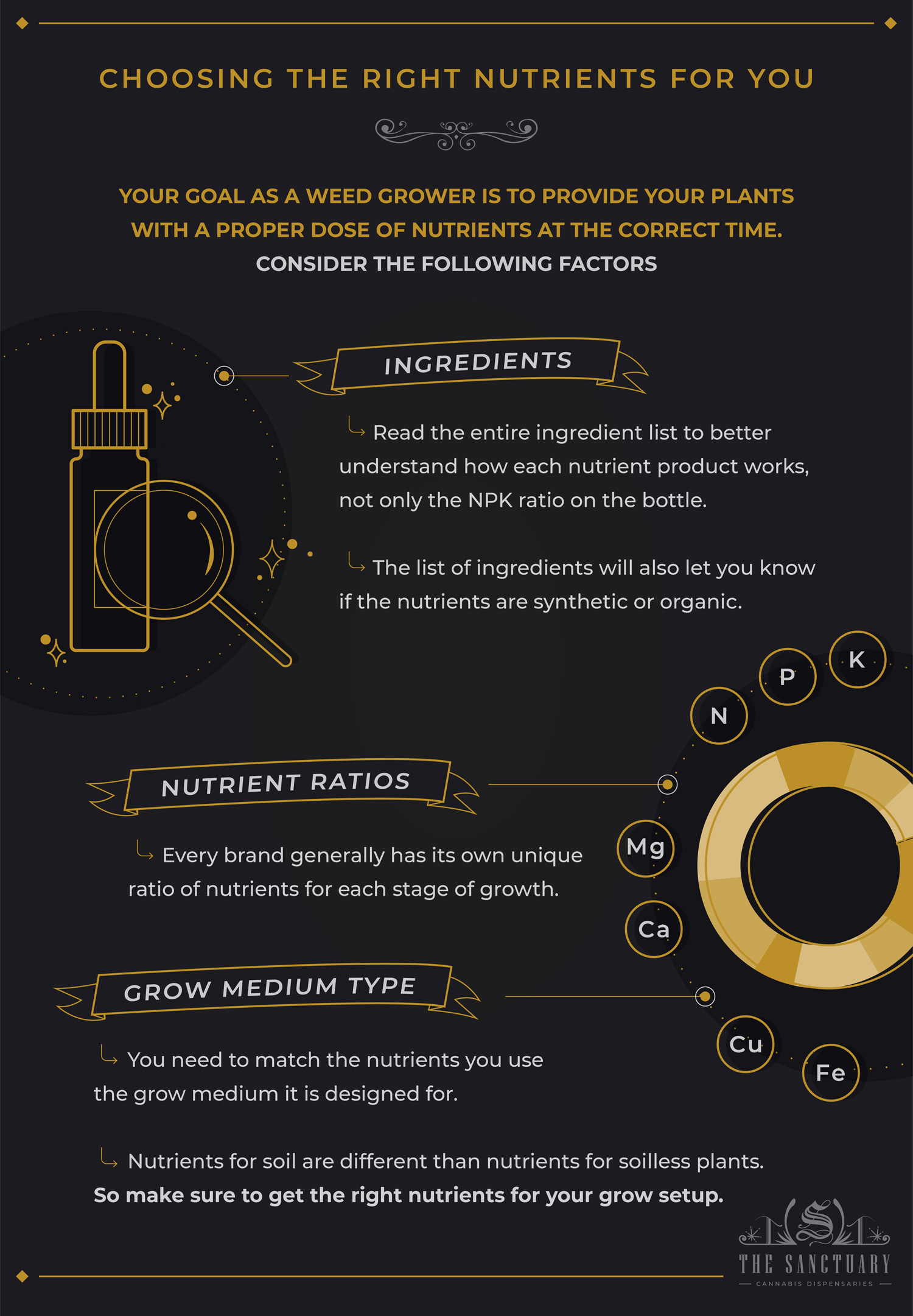Nutrients are essential for cannabis plants to thrive but if you go overboard with them you can destroy your plants with what is called “nutrient burn.” Nothing is more disheartening than killing your precious plants.
The goal for weed growers is to produce a bountiful harvest. Water, air, and light are major elements in achieving that goal, but nutrients are also crucial to increasing bud growth.
The environment naturally produces all of the nutrients needed for cannabis plant development. However, for indoor grows or outdoor plants in less than stellar soil situations, the addition of nutrients is necessary.
What are nutrients?
Nutrients are food for a plant and are composed of naturally occurring or synthetic substances that get applied to the soil the plants are growing in. These nutrients are also beneficial to any other plant, so you can use them to spruce up your house plants.
Growers who cultivate plants outdoors usually add a nutrient powder to the soil when they are transplanting a cannabis plant outside. This provides the nutrients the plant needs for the entirety of its lifespan. If you need to add more nutrients later, you can just pour some on top of the soil.
What nutrients does a cannabis plant need?
The weed plant needs a plethora of vital nutrients. Plants take micro and macronutrients from the air, water, and soil.
The macronutrients that weed plants need to grow include:
- Nitrogen (N)
- Phosphorus (P)
- Potassium (K)
Weed plants need micronutrients in smaller quantities. The micronutrients that cannabis plants need to grow include:
- Magnesium
- Calcium
- Copper
- Iron
Weed plants also procure the following non-mineral elements from water and air:
- Hydrogen
- Carbon
- Oxygen
Various amounts of nutrients are needed by weed plants throughout their different life cycles.
Nitrogen
A plant in the vegetative cycle is dependant on nitrogen for achieving the proper level of development. Chlorophyll is what allows plants to convert sunlight into energy and this can only happen with the presence of nitrogen.
Nitrogen also contributes to the development of amino acids which are crucial as the plant’s source of protein. Your weed plants will suffer from a growth disorder without the proper levels of protein. Nucleic acid is also created by nitrogen which is responsible for cell growth and multiplication.
Phosphorus
Phosphorus is a key element in the production of large-sized buds. The job of phosphorus is to encourage nutrients to become available for the plant to absorb. Those nutrients help develop the plant’s structure and growth from the flower to the roots.
Cannabis plants run the risk of not being able to produce flower if it has inadequate levels of phosphorous. Phosphorus deficiency can become visible if the veins of the leaves develop a purplish hue.
Potassium
The jobs for potassium mostly involve regulating the systems that keep a plant healthy and thriving. It regulates the concentration of salt and water in the plant. Potassium achieves this by monitoring the opening and closing of the stomata – the major factor in how plants exchange H2O, oxygen, and CO2.
Potassium also engages the development of ATP (adenosine triphosphate), which is responsible for creating glucose which stores the energy that was produced during photosynthesis. The plant needs glucose for energy at all cycles of life. Potassium deficiencies cause the plant to lose its ability to exchange H2O, oxygen, and CO2.
Calcium
The cell walls depend heavily on calcium to uphold their structure. Plants cannot develop new growth if there is an absence of calcium. They will look stunted, with curled-up leaves and yellow and rusty spots all over.
Magnesium
Magnesium is also important for the production of glucose. Without it, sunlight can not be converted into energy.
After creating glucose, magnesium metabolizes it so that it can be utilized by the plant. Magnesium deficiencies also cause the leaves to curl and turn yellow in color.
How to read nutrient labels
The number of brands that produce nutrients for cannabis is excessive so naturally looking for the right nutrients for you can be a challenge. Nutrient labels can look like gibberish to the average person. Inexperienced growers need to understand nutrient labels so that they can use them properly.
Most nutrient labels list numbers for NPK – nitrogen (N), phosphorus (P), and potassium (K). The numbers represent the percentage of each nutrient that is in the specific product. As an example, 6-12-10 NPK means the solution has 6 percent of nitrogen, 12 percent of phosphorus, and 10 percent of potassium.
Do not go out and get an “all-purpose” nutrient product. Weed plants need specific ratios of nutrients in each cycle of development and therefore a generic plant nutrient mix will not be sufficient.
There is no magic ratio of NPK that is superior to others, it all depends on each company’s opinion and research of what weed plants like best.
Choosing the right nutrients for you
Each nutrient company will act as if their product is the best, but in fact, there is no guarantee which one is best for your plant and its soil. Experience using different brands will help, but there are general guidelines to help choose the right nutrients for your growing needs.
Your goal as a weed grower is to provide your plants with a proper dose of nutrients at the correct time. Each stage has varying nutrient requirements. The two main stages of life for a weed plant are the vegetative stage and flowering stage.
When deciding which brand of nutrients to use, consider the following factors:
- Ingredients: Any different combination of organic chemical compounds can add up to identical nutrient ratios. Each chemical compound will have an effect on your cannabis plants. Therefore, the NPK ratio on the bottle does not tell the full story. Be sure to read the entire ingredient list to better understand how each nutrient product works. The list of ingredients will also let you know if the nutrients are synthetic or organic.
- Nutrient Ratios: Every brand generally has its own unique ratio of nutrients for each stage of growth.
- Grow medium type: You need to match the nutrients you use to the grow medium it is designed for. Nutrients for soil are different than nutrients for soilless plants. So make sure to get the right nutrients for your grow setup.
Organic nutrients for cannabis
Animal and vegetable waste are typical sources of organic nutrients. You may have heard of outdoor growers using their own compost for their nutrients. This is possible if you monitor your compost pile and provide it with a balance of materials.
Outdoor growers also commonly use sediments for nutrients such as gypsum and glacial rock dust; these contain helpful minerals for the plant and soil. These are typically purchased in powder form.
Most organic nutrients are available for purchase at garden stores or nurseries. They are easy to use; just mix them into your soil as you transplant your baby plants. This should be enough nutrients for the majority of the plant’s life. You may need to add more if you are growing in poor-quality soil.
Below are some examples of organic nutrients:
- Dolomite lime for magnesium and calcium
- Epsom salts for sulfur and magnesium
- Fish meal or blood meal for nitrogen
- Bat guano or bone meal for phosphorus
- Kelp meal or wood ash for potassium
When should you feed your plants with nutrients?
At different stages of growth, cannabis plants need different levels of nutrients. The medium you grow from also determines when and how much to feed your plants.
For weed grown in soil, the optimal pH balance ranges between 6.0-6.8. Hydroponic plants want to maintain a pH balance of 5.5-6.5. Plants in veg need about a gallon of water a day. Of course, if your plant is outdoors then rain may do your job for you.
Here are some guidelines for when to give your plants nutrients:
- Seedling: These do not need any nutrients. You should not start feeding nutrients to your seedlings until multiple leaves have grown.
- Vegetative: You want to initially use a 2:1:2 NPK ratio. Around the seventh week, you should boost the NPK ratio to 10:5:7. Later in the vegetative phase use a ratio of 1:1:1.
- Flowering: In this stage, discontinue feeding the plant with nitrogen. You want to begin increasing the levels of phosphorus and potassium. Feeding plants early in the flowering phase is fine but once their buds are beginning to take final form, no more feeding is necessary.







